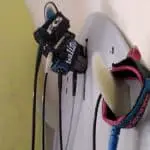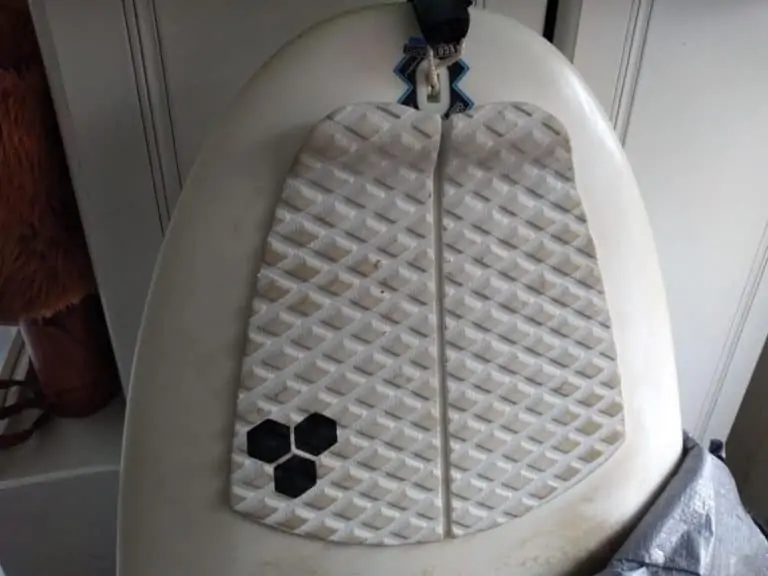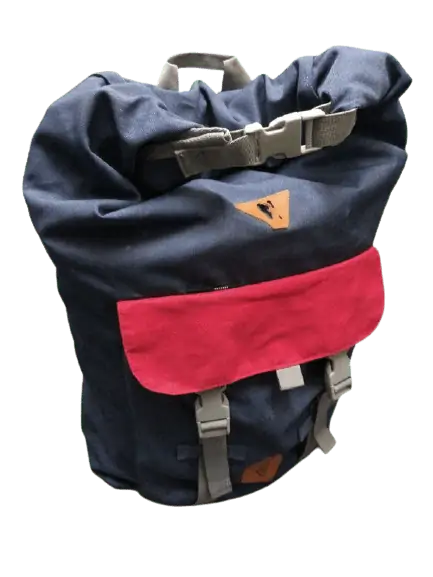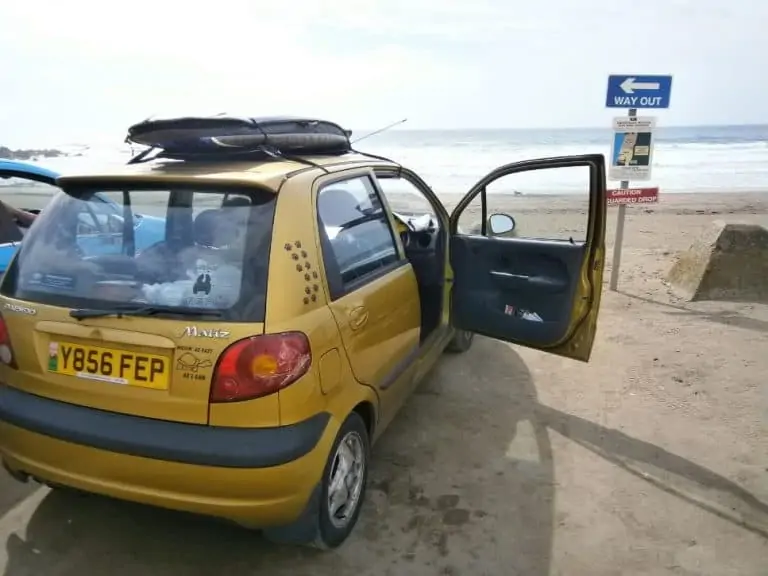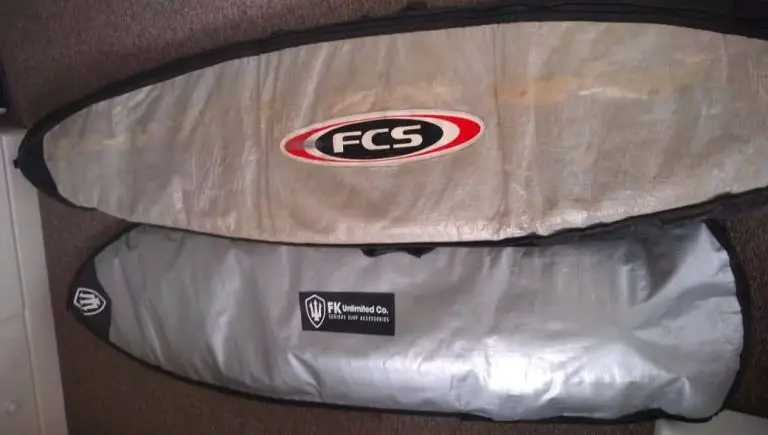Surfer Starter Pack: EVERYTHING You Need!
Starting surfing needs a fair bit of gear to get going, with lots of choices to make along the way.
However, if you know what you need from the start, the whole process doesn’t need to be too difficult and can actually be quite a lot of fun.
So, what do you need to start surfing? The easiest is to start with a surf lesson as they will supply everything included in the price! To start surfing on your own, a soft foam board (size guide below) that is either hired or used is fine (no need to buy new). Get a wetsuit if the water is cold (temperature guide below).
With that said, let’s have a look at the finer points to help you get out into the surf with all the right gear and nothing more.
What You Need to Start Surfing by Learning with a Surf School
A surf school will provide all the gear you need to start surfing, making it an appealing option to begin your surfing adventure. The kind of things you will get to use during your surf lesson are the right kind of board for learning on, a wetsuit and you will also be supervised by qualified instructors.
This is really helpful since the instructors will think of everything for you and make it a lot easier than if you try and go on your own to start surfing.
By having a surf lesson, you will also get further information, including insight on when the best time to go surfing is and the best spot on the beach for learning.
It’s also by far the best option if you are completely new to surfing and are not sure if you will be going again (in case you don’t like it, although I think you will!).
That said, even if you have a surf lesson, you will still need to buy some gear to get going, so we’ll look at all the aspects of this below.
Learn to Surf On Your Own: Essential Surfing Gear
Surfboard
The first thing to think about is a surfboard, for obvious reasons. Although you can hire them out at the beach, doing this a few times can quickly become expensive and will soon be the same or more than buying a board yourself.
When looking for your first surfboard, look for a board that is about 2 feet longer than you are tall and wide and round in the nose and tail (anything else should be avoided) and a board that is made of soft foam construction wherever possible.
For more on choosing your first surfboard, check out this awesome guide that I prepared about choosing a beginner surfboard!
However, there is no need to buy your first surfboard new; used or second-hand surfboards are usually fine, even if you are totally new. This can help you save a lot of money and also takes the risk out of learning to surf since the cost of a used board will usually be about half that of a new surfboard.
If you go for a used surfboard, just make sure that you can see it in person before agreeing to a sale or paying for it. A couple of key checks you will want to perform when buying a used surfboard are things like holding it to feel its weight. If a used board weighs a ton and looks old, it’s probably waterlogged, which is a hassle you do not want!
Otherwise, look for obvious things like cracks or ‘dings’, holes or damage to the surfboard in surfing terms. If they are small, repaired and not discolored, then these should be fine.

Surfboard Fins
Along with your surfboard, you will also need to get some surfboard fins as these are what control your board through the water (without them, you will just spin constantly and go nowhere!).
If buying used, you might be able to get these included, although the ad that you see online should say if the fins are included or not.
If buying a new surfboard, fins are not often included again check the website or ask the sales clerk in a store. Some stores might do a deal where they can throw in a discounted set of fins with your board, so think about that angle, too.
Again, you can buy used surfboard fins but this is only recommended if you know the exact type of fin that you need since there are many different types that are not all compatible with each other. Typical fin systems are by brands like FCS or Futures, but most learner surfboards will come with fins so it shouldn’t be a major issue.
When buying your surfboard, also remember to get some wax for grip! You can’t surf without it as you will slip off your board instantly. It’s usually pretty cheap ($3 for a bar or block) and most surf stores will throw in some wax free with a board. If buying your board used, it might also have some wax on it but just make sure it’s there or that you have some before hitting the waves!
Leash
To keep you safe, a leash is another essential bit of any surfer starter pack! The leash will keep you attached to your board when you fall, making surfing a lot safer for you and for others.
Keeping a connection with your board means that you will always have a float (i.e. your board!) when you are out in the surf, as well as meaning that your board won’t wash in to shore each time you fall off (a long swim, trust me!).
To get a good leash for learning to surf, make sure it is the same length as your surfboard, or 1 foot longer if in doubt. This length will mean that it will function properly and won’t just fly back at you wildly every time, which is something that can happen with too short of a leash. Also remember that a ‘comp leash’ is for professional surfers only – you can ignore these as they are weak and won’t last long.
Remember to check out my recommended 11 accessories to buy with your new surfboard to take it up to the next level!
Wetsuit or Surf Clothing/Accessories
After a surfboard, the next big thing to think about is a wetsuit, and whether you actually need one that is!
You will know how warm the place you are planning to surf is, but it might not be obvious whether you will need a wetsuit or not.
Surfing in the Tropics
In general, if surfing in the tropics, you will not need a full wetsuit at any point in the year. However, you might want a wetsuit top when the water is a little cooler in places like Bali. From having lived there for close to 3 years, I can confirm that the water did get a little chilly, so don’t just think about the air temperature!
I’d also recommend a good pair of boardshorts by a surf brand for both men and women since these will stop you from getting rub/chafing. Although boardshorts don’t seem that technical, after a few hours in the surf the difference between a surf brand’s shorts and cheap ones will soon be painfully obvious!
Surfing in More Temperate Climates
If, like most of us, you will be learning in a more temperate climate, then you will probably need a wetsuit at some point in the year.
Again, this depends on the water temperature, something which you can easily check online before going.
As a rule, I’d recommend starting surfing at the warmest time of year in your local climate since cold water surfing can be a lot harder with all the extra gear and accessories.
However, regardless of what time of year you start, I’d strongly recommend a chest-zip wetsuit from a brand like O’Neill, Xcel, Rip Curl, Vissla or Patagonia.
This because a wetsuit is an extremely technical piece of kit and will be a major help to your surfing progress. In fact, be sure to check my 10 tips on choosing the right wetsuit to get it just right!
If you need a guide to what thickness of wetsuit you will need, see below for a handy table with recommended water temperatures for each thickness of wetsuit. A word of warning: a 5/4mm or above is getting into the serious surfing realm, so only buy one of these if you are absolutely sure!
| Water Temperature | Wetsuit Thickness (mm) and Type |
| >70°F | Boardshorts and possibly wetsuit top; i.e. no wetsuit needed! |
| 65-70°F | 3/2mm or 2mm wetsuit with short arms or legs |
| 60-65°F | 3/2mm full wetsuit |
| 55-60°F | 3/2 mm full wetsuit(Boots optional) |
| 50-55°F | 4/3mm full wetsuit with boots |
| 45-50°F | 5/4mm full wetsuit with boots, gloves and a hood |
| <45°F | 6/5mm full wetsuit with boots, gloves, hood and thermals |
Sunblock
This is something that might sound like an optional extra but it really isn’t! Just like when you go skiing or snowboarding, a day out in the waves can be extremely intense for the sunlight you get exposed to, particularly your face.
As such, getting yourself a good, waterproof sunblock that is SPF30+ is a must. You can also find some nice organic options online if you don’t want to use more commercial products but make sure you wear something.
Although young surfers have a reputation for being blond and tanned, older surfers are often leathery, wrinkled and sadly quite a few do get more severe conditions from prolonged sun exposure.
So, that’s pretty much all the essential gear you will need, but below are a few other factors to consider that will certainly help you along the way and be a great asset to you when starting surfing.
Other Factors to Consider
Small waves
Always looks for small waves to learn on. These are safest and easiest and will simply make your surfing a lot more fun in the early days.
Don’t be in a rush here and remember to take your time. The smaller waves will have fewer people and will also be closer to shore, making them the perfect learn to surf conditions.
Right spot
To go along with small waves, you’ll also need to be surfing at the right spots when you learn. This could be your local beach, or somewhere further afield. The way to tell if a spot is good for learning is by looking at the waves and seeing how many learners there are, as well as surf schools.
If you don’t see many learners and no surf schools, then it’s probably a more advanced spot. Equally, if you see exposed rocks all over the beach and dumping waves, it’s likely best avoided and not somewhere to head out.
There are plenty of good spots for learning to surf so don’t force yourself into waves that aren’t good for learning.
Awareness
Staying aware of your level of ability and the conditions in the surf is something you will definitely need when you are out in the waves.
This sounds like a given but I am often surprised how many learner surfers I see who suddenly think that they are bulletproof!
It takes a long time to learn to surf properly, so be patient and have fun with it, only making the step up to the next level when you are ready.
The conditions can also change quickly so keeping your eyes open to those changes at all times will also help you to stay safe.
Friends (or at least other people)
Perhaps the best thing you can do when learning to surf is go with friends. This is because they will provide a safety net and you can all look out for each other.
The main issues for learner surfers are things like currents and collisions with others in the surf.
In the case of a current, your friends can raise the alarm if you get taken out to sea, while they can also check in with you if you have an accident in the waves like a collision with someone else or even your board.
Even if you can’t find any friends who are willing to learn to surf with you, at least go surfing in busy spots that have other people learning to surf as the old saying ‘safety in numbers’ is certainly true in surfing!
Car
If you are not one of the lucky few who lives right by the beach, then you will also need to have a car to get you back and forth.
Fear not: even small cars can handle large surfboards, something my wife and I know from experience!
My wife had a Chrysler Matiz (or Daewoo Matiz in Europe/Asia) which is a tiny car by anyone’s standards, yet this little thing could still carry an 8’0 long surfboard inside it by flattening the passenger seat and putting the board in from the trunk.
However, you can also get things like soft surfboard racks to carry boards on the roof of your car easily. These are inexpensive and go on and off quickly, meaning that you don’t need to have ugly roof racks on your car permanently, and you can even use them with a friend’s car if needed.
For more on turning a car into the ideal surf wagon, definitely check out my 6 essential surf accessories for any car.
